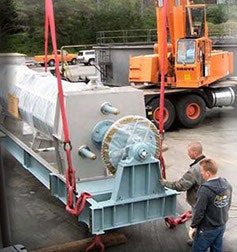Wastewater System Operations
Personnel
The Wastewater Department consists of seven experienced and highly trained professionals. The Department is managed by the Wastewater Systems Superintendent and the Utilities Department Manager and supported by the Program Manager and Administrative Technician II. All operators are certified by the State Water Resources Control Board for both wastewater treatment and distribution and undergo extensive continuing education to maintain their certifications.
Wastewater Facilities
The CCSD operates a one-million-gallon-per-day extended aeration-activated sludge secondary facility in Cambria. Treatment and disposal services are provided to approximately 6,000 residents. The original treatment plant was constructed in 1970. In 1995, a major upgrade was completed to improve the plant's ability to reliably meet the discharge requirements required by the Regional Water Quality Control Board.
The upgraded facility includes new concrete aeration basins and secondary clarifiers, which are sized to handle peak hydraulic and biological loads and allow maintenance without an interruption in service.
Following is a description of how wastewater is processed, treated, and disposed of through the Wastewater Plant.
Influent Pump Station
- Raw wastewater (sewage) reaches the treatment facility through multiple pump stations and 72 miles of gravity sewer pipeline.
- Influent flows are first measured in a metering manhole and then flow by gravity to the influent pump station.
- The raw wastewater is then pumped into the preliminary treatment process.
Preliminary Treatment
- During the preliminary treatment process, macerators grind the larger particles into smaller pieces to enhance treatment and removal.
- Wastewater then flows to an aerated grit chamber, where it is mixed with low-pressure air to help settle out grit and other dense solids.
- The grit and solids are separated, partially dewatered, and ultimately disposed of in a landfill.
- After initial treatment, wastewater flows by gravity to the flow equalization system.
Flow Equalization System
- This system allows wastewater to be delivered to the secondary treatment process at a constant rate, which plant operators set daily.
- During daily peak flow periods or routine storms, wastewater is diverted to two steel equalization tanks where it is stored until it can be pumped to the secondary treatment process at a steady rate.
- During peak storms, flows are diverted further into three flow equalization ponds.
- After the storm event, the diverted water is sent back through the treatment system.
Extended Aeration Basins
- Wastewater from the flow equalization system enters the secondary treatment process in the extended aeration basins.
- Fine bubbles of air are injected through diffusers on the bottom of the tank, providing oxygen for living microorganisms produced and maintained as part of the activated sludge process.
- These organisms, known as "mixed liquor," break down and consume the organic material in the wastewater and build new cell mass. This cell mass is then settled in the secondary clarifiers.
Secondary Clarifiers
- The mixed liquor created in the extended aeration basins flows into the secondary clarifiers, where solids settle to the tank bottom.
- Some of this settled material is pumped back to the aeration basins as return activated sludge to maintain biological processes.
- The excess settled material is wasted, meaning it is pumped to aerobic digesters as waste-activated sludge.
Sludge Digestion
- Sludge digestion takes place in the outer chamber of two package treatment plants that previously provided all secondary treatment processes.
- Bacteria decomposes the sludge, leaving only an inert residual material.
- Decanted, digested sludge is periodically pumped to tanker trucks for land spreading in Kern County.
- The package treatment plants also serve as backup secondary treatment units when the clarifiers or aeration basins are being serviced or repaired.
Effluent Disposal
- After secondary treatment, plant effluent is disinfected with sodium hypochlorite and flows to the effluent pump station.
- It is pumped to a reservoir or to four percolation basins located two miles north of the treatment plant along San Simeon Creek.
- The percolation basins create a saltwater barrier and lower the hydraulic gradient of our well field, allowing the District far greater access to upstream potable water for longer periods of time.
Blower Building
- In the blower building, blowers provide air for the plant's aeration and mixing for the biological processes.
Biosolids Dewatering

In November 2002, the CCSD Board of Directors approved the purchase of new Biosolids Dewatering equipment for the Wastewater Treatment Plant. The system was constructed and installed by employees of the CCSD Wastewater Department and has been operational since 2008.
Currently, biosolids from the plant are being hauled to Kern County for disposal. This equipment has significantly reduced waste transport costs and improved the quality of Cambria's waste.
The dewatering equipment extracts water from the waste, disinfects it, and pasteurizes it, resulting in a higher-quality end product that can be disposed of locally and potentially used as soil amendment.

.jpg?ixlib=rb-1.1.0&or=0&w=720&h=720&fit=max&auto=format%2Ccompress&s=94ea4e773b692ec24ba8997dc60aa29e)

